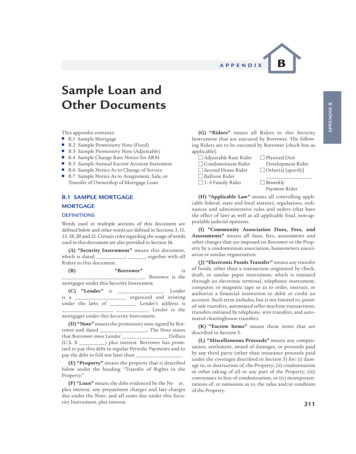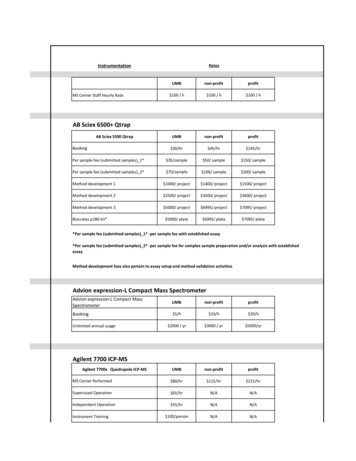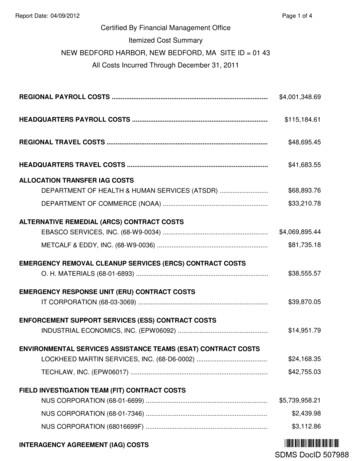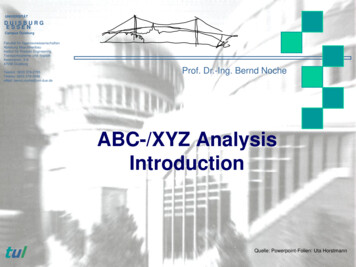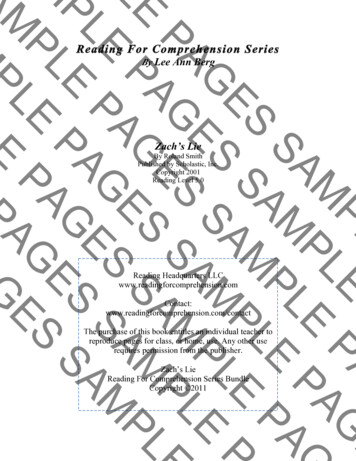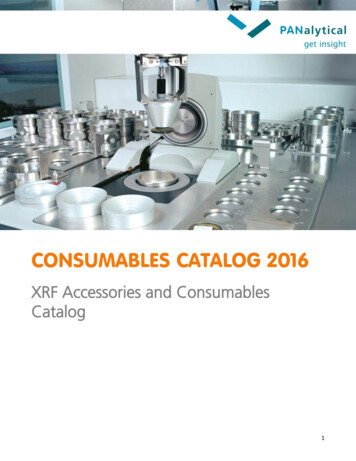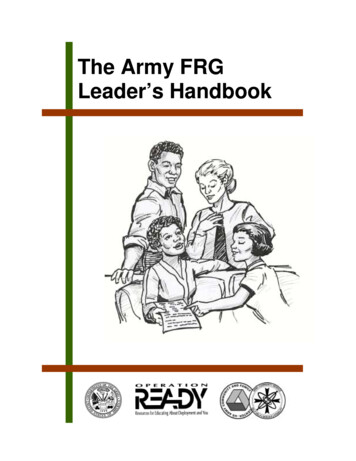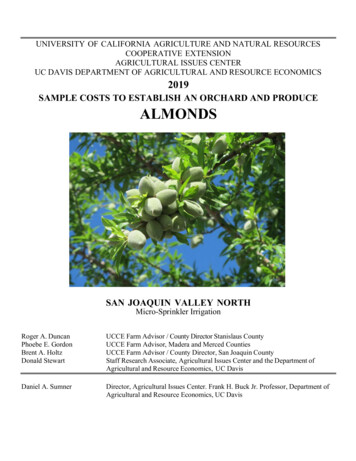
Transcription
UNIVERSITY OF CALIFORNIA AGRICULTURE AND NATURAL RESOURCESCOOPERATIVE EXTENSIONAGRICULTURAL ISSUES CENTERUC DAVIS DEPARTMENT OF AGRICULTURAL AND RESOURCE ECONOMICS2019SAMPLE COSTS TO ESTABLISH AN ORCHARD AND PRODUCEALMONDSSAN JOAQUIN VALLEY NORTHMicro-Sprinkler IrrigationRoger A. DuncanPhoebe E. GordonBrent A. HoltzDonald StewartUCCE Farm Advisor / County Director Stanislaus CountyUCCE Farm Advisor, Madera and Merced CountiesUCCE Farm Advisor / County Director, San Joaquin CountyStaff Research Associate, Agricultural Issues Center and the Department ofAgricultural and Resource Economics, UC DavisDaniel A. SumnerDirector, Agricultural Issues Center. Frank H. Buck Jr. Professor, Department ofAgricultural and Resource Economics, UC Davis
UNIVERSITY OF CALIFORNIA AGRICULTURE AND NATURAL RESOURCESCOOPERATIVE EXTENSIONAGRICULTURAL ISSUES CENTERUC DAVIS DEPARTMENT OF AGRICULTURAL AND RESOURCE ECONOMICSSAMPLE COSTS TO ESTABLISH AN ORCHARD AND PRODUCE ALMONDSSan Joaquin Valley North - 2019CONTENTSINTRODUCTIONASSUMPTIONSEstablishment Cultural Practices and Material InputsTable A. Production InformationProduction Cultural Practices and Material InputsHarvest, Yield and RevenueLabor, Equipment and Operating InterestCash OverheadNon-Cash OverheadREFERENCESTable 1. COSTS PER ACRE TO ESTABLISH AN ALMOND ORCHARDTable 2. COSTS PER ACRE TO PRODUCE ALMONDSTable 3. COSTS AND RETURNS PER ACRE TO PRODUCE ALMONDSTable 4. MONTHLY CASH COSTS PER ACRE TO PRODUCE ALMONDSTable 5. RANGING ANALYSISTable 6. WHOLE FARM ANNUAL EQUIPMENT, INVESTMENT & BUSINESS OVERHEADTable 7. HOURLY EQUIPMENT COSTSTable 8. OPERATIONS WITH EQUIPMENT AND Sample costs to establish an almond orchard and produce almonds are presented in this Study. This analysis doesnot represent any single farm and is intended as a guide only. It can be used to help guide production decisions,estimate potential returns, prepare budgets and evaluate production loans. Sample costs given for labor, materials,equipment and contract services are based on August 2019 figures. The same sample costs (ex. Labor rates) areused from establishment through the production years, knowing that costs will change from year to year. A blankcolumn titled Your Costs is provided in Tables 1, 2 and 3 for your convenience.For an explanation of calculations used refer to the section titled Assumptions. For more information contactDonald Stewart; University of California Agriculture and Natural Resources, Agricultural Issues Center,Department of Agricultural and Resource Economics, at 530-752-4651 or destewart@ucdavis.edu. To discussthis study with a local northern San Joaquin valley extension advisor contact your county cooperative extensionoffice. ucanr.edu/County Offices/Sample Cost of Production studies for many commodities are available and can be downloaded from theDepartment website, coststudies.ucdavis.edu. Archived studies are also available on the website.Costs and Returns Study Program/Acknowledgements. A “costs and returns” study is a compilation ofspecific crop data collected from meetings with professionals working in production agriculture from the regionthe study is based. The authors thank the farmer cooperators, UC Cooperative Extension and other industryrepresentatives who provided information, assistance, and expert advice. The use of trade names and culturalAlmonds Costs & Returns StudySan Joaquin Valley, North-2019UCCE, UC-AIC, UCDAVIS-ARE2
practices in this report does not constitute an endorsement or recommendation by the University ofCalifornia nor is any criticism implied by omission of other similar products or cultural practices. TheUniversity is an affirmative action/equal opportunity employer.ASSUMPTIONSThe assumptions contain background in developing Tables 1 to 8 and pertain to sample costs to establish anorchard and produce almonds under micro-sprinkler irrigation in the northern San Joaquin Valley. The culturalpractices described are based on production practices considered typical for the crop and area, but will not applyto every situation.This study explains the annual costs associated with an ongoing operation, under the assumptions that the farmwas operated this way in prior years and will continue in subsequent years. The costs, materials, and practices inthis study will not apply to all farms. Timing of and types of cultural practices will vary among growers withinthe region and from season to season due to variables such as weather, soil, and insect and disease pressure.Farm. The hypothetical farm consists of 105 contiguous acres farmed by the owner. Smaller non- contiguousparcels may have additional costs for travel time and equipment re-calibration. Larger farms will have increasedefficiencies and lower per acre costs. Almonds are being established on 100 acres; roads, irrigation systemsand farmstead occupy five acres.Establishment Cultural Practices and Material InputsSite Preparation. This 100-acre orchard is established on land previously planted to an orchard. The land isassumed to be well drained and either a class I or II soil. The existing well and main lines stay in place, while thesub-main lines, lateral lines and emitters are removed and replaced as part of the new micro-sprinkler irrigationsystem.Orchard Removal/Land Preparation. As soon as possible after the last harvest, orchard removal begins with theextraction of the irrigation system. Once the lateral and emitter lines are removed, a custom operator uses a dozerto push over the trees. A front end loader with a clamp grasps the trees and hauls them to the horizontal grinderto mulch the wood. The chips are spread over the entire orchard. The ground is ripped at a 3-foot depth down thetree rows. The field is cross-ripped (or at 45 angle) to a 6-foot depth to break up hardpan and pull up remainingtree roots. The field is disced twice and laser leveled then left unattended until a custom operator is hired tofumigate and tarp each tree row area (11-foot strip) with Telone C35.Planting. Prior to planting in January, using GPS, a custom operator marks the planting sites. The tree row bermsare created with the mechanical planter when planting the trees. After planting, the irrigation lines are laid outand the area between the tree rows are floated/smoothed which also fills in the berms borrow pits. Fall operationsthat prepare the orchard for planting are done the year prior to planting, but costs are shown in the first year.In January, the trees are topped, planted, trimmed and a tree wrap is placed around the trunk. The tree wrap,(carton) protects against above ground rodents, herbicide sprays, and sunburn. The trees are given 3-5 gallons ofwater (by hand) at planting to settle the soil around the roots. Contract labor companies who specialize in orchardplanting do the planting operation using a machine. The trees are not staked. In the second year, two trees peracre are replanted and this cost is reflected in the establishment costs.Trees. No specific almond variety is planted. The trees are grown in pots at the nursery. Almond orchards willinclude two or more varieties in which bloom periods overlap to insure good pollination. Self-fertile varietiesAlmonds Costs & Returns StudySan Joaquin Valley, North-2019UCCE, UC-AIC, UCDAVIS-ARE3
are available. Having two or more varieties in the orchard can affect cultural practices including harvest. Thevarieties do not mature at the same time. The custom crew will harvest one variety and will have to come back toharvest the other variety. Cost of the trees include scion wood and rootstock patents. Planting densities rangefrom 75 to 180 trees per acre. For this study, 130 trees per acre are planted on a 16’ X 21’ spacing (tree x row).The life of the orchard at the time of planting is estimated to be 25 years.Train/Prune. Training, which includes suckering and light pruning for shaping is done from September-Februaryof the first non-bearing years. Tree tying, to prevent scaffold breakage after pruning is done late in the secondyear or early in the third and fourth years. The tie (using small rope) is made around the tree about one-third ofthe way from the top of the tree. The young trees are pruned late to avoid bacterial canker. In the fourth andfollowing years, pruning is done in November – January, removing limbs for equipment access and safety.Fertilization. Fertilizer rates shown below are typical nutrient requirements, but do not consider soil and waternitrogen. In the first year, equal applications of a granular fertilizer are made once per month starting in Marchand continuing through July. The fertilizer, 15-15-15 is broadcast by hand near the base of the tree. Althoughpotassium and phosphorous fertilizers are generally not necessary for new trees, 15-15-15 is often used becauseit is safer than straight nitrogen fertilizers.Table A has the recommended amount of nitrogen for the first and following years. Incorporating the chips intothe soil will tie-up nitrogen. After planting in the first year, additional nitrogen if required from tie up in the soil,could be applied through the irrigation system. Research has not shown increased nitrogen rates are required forthe second and third year old trees in orchards with incorporated wood chips.In the second year, N is applied monthly from April to August through the irrigation system. CAN-17 (10% ofN budget) is applied during the first two applications and UAN32 thereafter. In year three and the followingyears, UAN32 is applied monthly from March-May, with one additional after harvest application of N. Potassiumsulfate (K2SO4) is banded along the tree row in the fall.In years one and two, zinc is applied with the rust spray in late March and with the shot hole/scab spray in thefollowing years. In October of the second and subsequent years, Solubor (boron) is applied as a foliar spray.Many orchards on the eastside of the northern San Joaquin Valley are boron deficient and additional boronmay be required. Annual rates of actual N, K, and B applied are shown below.Table A. Production Information.YieldsYear123456 *Lbs./Acre4008001,6002,200Fertilizer Lbs /AcreN356090120160220*Yield is measured in kernel (meat) lbs. per 2.0Sampling. Tree nutrient status is determined by leaf and hull analysis. In years 1-3, leaf samples are taken todetermine nitrogen deficiencies. Hull samples for boron analyses are taken from the windrow at harvest. ThePCA sends the samples to a commercial lab for analysis. The charges shown are for the lab analysis.Irrigation. Water is pumped from a well and passes through a filtration system into the micro-sprinklers. WaterAlmonds Costs & Returns StudySan Joaquin Valley, North-2019UCCE, UC-AIC, UCDAVIS-ARE4
is applied to the orchard approximately twice a week from mid-March through mid-October. Price per acre-footof water will vary by grower depending on water source – well or district water, well characteristics, and waterdistrict. Irrigation pumping costs are estimated at 100 per acre-foot or 8.33 per acre-inch. Table A shows theapplied water for each year. Applied water values are substantially greater than the actual tree water requirementdue to application inefficiency. Application efficiencies of 90 percent are used for all years and reflect thedifferences in evaporative loss due to canopy development. Effective rainfall is not considered because it is toovariable. It is assumed that the season begins with a full soil profile.Sustainable Groundwater Management Act (SGMA). SGMA requires governments and water agencies of highand medium priority basins to halt overdraft and bring groundwater basins into balanced levels of pumping andrecharge. For detailed information visit the website;water ca er-ManagementFrost Protection. Frost protection begins in the fourth year and uses two acre-inches annually. Protection maybe needed from February through March; however, it may not be needed every year and the amount of protectionwill vary. This water is in addition to the amounts of water shown in Table A, with Table 3 showing total waterapplied.Irrigation System Maintenance. The micro-sprinkler irrigation system requires chemical flushing to retard calciumbuildup and emitter clogging. This operation is performed annually after harvest with N-pHuric acid appliedthrough the system with 0.25 acre-inches of water.Pollination. A commercial beekeeper sets out one-half hive per acre in the third year, one hive in the fourth yearand two hives in the fifth year and following production years (Table A). Bee colony strength should be a standard8 frames per hive and the cost is 200 per hive.Bees. Bees are sensitive to pesticides and timing of applications must coordinate with bee pollinating activity.See the individual pesticide labels, environmental hazards section. For more information visit the websites listedbelow. ipm ucanr edu/beeprecaution/honeybeehealthcoalition org/wp-content/uploads/2017/05/HBHC grower flyer v9 pdfThe Almond Board of California recently refreshed the BMPs, (Honey Bee Best Management Practices)incorporating new tips and resources that growers and other stakeholders can use to protect honey bees and planfor a productive pollination. almonds com/pollinationPest Management. The pesticides and rates mentioned in this cost study, as well as other materials available, arelisted in the UC Integrated Pest Management Guidelines for Almonds and the 2017 Fungicide Efficacy andTreatment Timing for Almonds publication located on the UC IPM website at ipm ucanr edu For information onother pesticides available, pest identification, monitoring, and management, check with your PCA and/or visit theUC IPM website. For information and pesticide use permits, contact the local county agricultural commissioner'soffice.Pest Control Adviser/Certified Crop Advisor (PCA/CCA). The PCA/CCA monitors the field for agronomicproblems including pests and nutrition and writes recommendations for pesticide applications. Growers may hirea private PCA/CCA or receive the service as part of a service agreement with an agricultural chemical andfertilizer company. The PCA/CCA does not charge any fees for monitoring the orchard. The costs are reflectedin the price of fertilizer and chemicals as part of the service contract between the grower and the PCA.Almonds Costs & Returns StudySan Joaquin Valley, North-2019UCCE, UC-AIC, UCDAVIS-ARE5
Vegetation Management-Weeds. In the first year, Gramoxone and Prowl are applied to the tree row (strip spray)in February soon after planting. Also, the row middles are disked, floated and then mowed four times duringthe year. Spot sprays are usually applied as needed. Gramoxone is applied as a spot spray in the tree row duringJune.In the second year, the row middles are mowed seven times, once per month from March through Septemberand six times thereafter, March through August. Roundup is applied as a spot spray, once (April) during thegrowing season to the tree row in the second year, but is usually applied as needed. Prowl and Roundup areapplied to the tree row during the dormant season (December).Beginning in the third year, the dormant strip spray (Matrix and Roundup) is applied to the tree row in thefall, or winter (November). A pre-harvest spray (Roundup and Goal 2XL) is applied to the orchard floor startingin the third year to clean up the row middles prior to harvest.Insects and Mites. In May of the first and following years, mites are controlled with an Abamectin applicationusing a handgun and UTV sprayer. Starting in the second year an Air-blast sprayer is used to apply the materials.Beginning in July of the third year, ant bait (Clinch) is sprinkled on the berms for ant control.Beginning in the third year and in subsequent years, navel orangeworm, Amyelois transitella (NOW) is monitoredusing pheromone traps with lures as well as egg traps (& female traps in many orchards). The traps are placed inthe orchard in March or April to monitor insect flights through hull-split. Insecticide applications of Intrepid 2Ffor NOW is applied twice, (two varieties) in separate applications at hull split in July. These applications aredependent on pest pressure, more or fewer applications may be needed. Other insecticides and timing may beutilized depending upon insect type and pressure. All the traps are monitored by the PCA/CCA and the costs areincluded in their fees.Winter Sanitation. Winter sanitation, November - January destroys overwintering sites and spring food sourcesfor NOW, begins in the third year and continues for the life of the orchard. A custom operator shakes andsweeps the mummies. The mummy nuts are either hand-poled (this operation is not very common) or shakenfrom the trees and swept/blown into the row middle. The nuts are left on the ground and shredding/mowingoccurs February or March by the grower.Some years, mummy nuts stick worse than others ensuing that more labor for hand polling may be required. Thisstudy shows the hand labor charges combined and split over two years.Diseases. Rust control is done in the first and second year with an application of Abound (zinc included withspray). In the third and following years, brown rot is treated in February (60% to 80% bloom) with Vangard; shothole, scab and rust are treated in March (petal fall or afterwards) with Pristine or Abound (zinc included withspray). Bravo is applied at petal fall for shot hole, scab and anthracnose. Sprays are usually applied with ahandgun sprayer during the first two years and with an air-blast sprayer thereafter. Materials are applied atreduced volumes during the first three years because of the small tree size.Vertebrate Pests. Treatments will vary depending upon rodent populations and orchard location. Gophers aremanaged the first three years with bait. Beginning in the fourth year, gophers are thought to be under control andspot treatments are used as necessary. Ground squirrels are controlled with traps along the perimeter of theorchard. The grower uses a UTV to check the traps. See the following websites for additional information.ucanr.org/sites/Ground Squirrel BMP/.ipm ucdavis edu/PMG/menu vertebrate html.Almonds Costs & Returns StudySan Joaquin Valley, North-2019UCCE, UC-AIC, UCDAVIS-ARE6
Harvest. Mechanical harvesting, (shaking) by a custom operator starts in the third year; albeit, great care istaken when shaking the trees in the first harvest year as to not damage the root system. The nuts are swept/blowninto the row middles and picked up mechanically. Typical annual yields for almonds are measured in meat (kernel)pounds per acre and are shown in Table A.Production Cultural Practices and Material InputsPruning. After the establishment years, only maintenance hand pruning for safety and equipment access isnecessary. This is usually completed in November – January but can be done anytime from harvest throughthe dormant period. Prunings are stacked in the row middles and shredded by a custom operator. Tying androping may continue to year 7 or 8 depending on previous training and variety.Fertilizer. Nitrogen (N) at 220 pounds per acre per season as UAN-32 is applied monthly March throughSeptember, with one application after harvest (October) through the irrigation system. Neutral zinc at five poundsper acre is foliar applied with an insecticide or fungicide spray at pink-bud in March. Potassium sulfate is bandedin the fall after harvest (October) along the tree row at 350 pounds K2SO4 per acre. Boron, at 0.4 pounds peracre, using Solubor (20.5%), is foliar applied in October.Sampling. Leaf samples are collected by the PCA in July to analyze tree nutrient status. Hull sample are takenfrom the windrow at harvest. If this sample shows a boron deficiency, a post-harvest boron application should beapplied before leaf drop. The PCA collects and sends the samples to a commercial lab for analysis. The chargesshown are for the lab analysis.A water analysis is done annually to determine nitrate availability, maintain regulatory records and monitor toxicelements (chlorine and sodium). A well test to determine pumping rates is also done at this time. The charges areshown in combination.Irrigation. Irrigation costs include pumping (water) and labor costs. The water is pumped from a well and abooster pressurizing pump pushes the water through the filtration system and out into the micro-sprinkler system.Forty-two acre-inches of water are applied to the orchard based on 90 percent application efficiency from Marchto October. Applied water values are greater than the actual tree water requirement due to application inefficiency.Water cost or pumping costs are 8.33 per acre-inch, ( 100/AcFt) based on current pumping rates. Rates willvary depending upon pump and well specifications and rate program selected. Irrigation labor is listed as aseparate line item.Frost Protection. Frost protection may not be required every year and the amount of protection needed will vary.An additional two acre-inches (in addition to the amounts shown in Table A.) are applied in February and/orMarch for frost protection.Pollination. Two hives (8 frames/hive) per acre are contracted for pollination and set in the orchard by thebeekeeper prior to bloom (February).Pest Management. The pesticides and rates mentioned in this cost study are listed in UC Integrated PestManagement Guidelines, Almonds. For information on other pesticides available, pest identification, monitoring,and management visit the UC IPM website at ipm ucanr edu.Vegetation Management-Weeds. A dormant strip spray is applied in November or December using preemergent and contact herbicides (Roundup, Matrix) to control weeds in the tree rows. Row middles are mowedsix times, once per month March through August. Rely is applied as a strip or spot spray in April/May or asAlmonds Costs & Returns StudySan Joaquin Valley, North-2019UCCE, UC-AIC, UCDAVIS-ARE7
needed. A pre-harvest spray (Roundup, Goal 2XL) is applied in August to prepare the orchard floor for harvest.Insects and Mites. Mites are sprayed with Abamectin in May. Clinch is applied on the berms in July for antcontrol. Dormant oil applications may be necessary if San Jose scale reaches a treatable level. Additional spraysmay be needed for occasional pests like peach twig borer or plant bugs.Insecticide applications of Intrepid 2F for navel orangeworm (NOW) is applied twice, (two varieties) in separateapplications at hull split in July. These applications are dependent on pest pressure, more or fewer applicationsmay be needed. Other insecticides and timing may be utilized depending upon insect type and pressure.Pheromone traps with lures as well as egg traps (& female traps in many orchards) are used to monitor NOW.The traps are placed in the orchard in March or April to monitor insect flights through hull-split. All the traps aremonitored by the PCA/CCA and the costs are included in their fees.Winter Sanitation. Winter sanitation, November - January destroys overwintering sites and spring food sourcesfor NOW, begins in the third year and continues for the life of the orchard. A custom operator shakes andsweeps the mummies. The mummy nuts are either hand-poled (this operation is not very common) or shakenfrom the trees and swept/blown into the row middle. The nuts are left on the ground and shredding/mowingoccurs February or March by the grower.Some years, mummy nuts stick worse than others ensuing that more labor for hand polling may be required. Thisstudy shows the hand labor charges combined and split over two years.Disease. Brown rot is controlled at 60 to 80 percent bloom in February with Vangard. Shot hole, scab and rusttreatments with Pristine or Abound, are made in March at petal fall or afterwards. Also at petal fall, brown rot,scab and anthracnose are controlled with an application of Bravo.Vertebrate Pests. Spot treatment using bait to control gophers is necessary in March and August. Ground squirrelsare managed using traps. The traps are placed on two sides of the field and moved regularly. The traps are checkedweekly from March through June and again in September and October. The costs of the traps, 8.50 per trap, areincluded in Shop/Field Tools under investments.Harvest, Yields and RevenueHarvest. A custom operator mechanically harvests the almond crop. Harvest begins in August with the earlymaturing varieties and continues into October for late maturing varieties. An inertia trunk shaker is the mostcommon shaker in almonds. The shaker head attaches to the tree trunk to shake the nuts from the tree. The nutsfall to the ground and are allowed to dry for about a week. In a separate operation, the nuts are swept into windrowsto be picked up. The grower furnishes labor for hand raking to move nuts missed by the sweeper into the windrows.A pickup machine gathers the nuts from the windrow and loads them into a cart or bankout wagon. The nuts arethen elevated into trailers for delivery to the huller.Orchards have more than one variety that mature separately. The custom operator harvests the earlier variety andwill come back a few weeks later to harvest the later maturing variety. Some varieties can be harvested together.Added costs for a second harvest are not shown since this study is based on per acre charges.Yields. Typical annual yields for almonds are measured in pounds of kernels (meats) per acre and are shown inTable A. Yields will vary by location, grower, year, and age of orchard. The assumption is the orchard willaverage 2,200 pounds per acre for the life of the orchard.Almonds Costs & Returns StudySan Joaquin Valley, North-2019UCCE, UC-AIC, UCDAVIS-ARE8
Revenue. The almond meats are sold for 2.50 per pound based on reported current returns, Table 3.Ranging Analysis. Table 5 shows a range of yields, 1,000 – 3,400 kernel pounds per acre over a range of prices, 1.00 - 4.00 per pound. Almond producers target yields and prices such that in general, lower yields tend to beassociated with higher prices. Therefore, the ranging analysis does not show the cases of very high yields withvery high return prices or very low yields with very low return prices.Almond Hulls and By-Products. The hulls are high in fiber and can be sold as a feed additive, normally for dairycows. No additional income from hull by-products are shown.Assessment. The Almond Board of California assesses all almonds commercially grown in the state to pay foralmond promotions and research. The mandatory assessment is paid by processors and is not reflected in growercosts. ams usda reased-assessment-rateLabor, Equipment, and Operating InterestLabor. Hourly wages for workers are 14.50 for machine operators and 12.50 per hour non-machine labor.Adding 41.72 percent for the employer’s share of federal and state payroll taxes, workers’ compensationinsurance, for nut crops (0045) and other possible benefits gives the labor rates shown of 20.55 and 17.72 perhour for machine labor and non-machine labor, respectively. Workers’ compensation costs will vary amonggrowers, the cost is based upon the average industry final rate as of August 2019. Labor time for operationsinvolving machinery is 20 percent higher than the equipment time to account for the extra labor involved inequipment set up, moving, maintenance, work breaks, and field repair.Managers Salary. No salary is shown. The farm is owned and operated by the grower, therefore returnsabove cost are assumed to go to management (grower).Equipment Operating Costs. Repair costs are based on purchase price, annual hours of use, total hours oflife, and repair coefficients formulated by American Society of Agricultural Engineers (ASABE). Fuel andlubrication costs are also determined by ASABE equations based on maximum power takeoff (PTO)horsepower, and fuel type. Prices for on-farm delivery of diesel and gasoline are 3.95 and 3.63 per gallon,respectively. The cost includes a 13.0 percent sales tax on diesel fuel and 2.25 percent sales tax on gasoline. Thecost also includes state excise tax for diesel and gasoline at 0.36 and 0.42, which are refundable for on-farmuse when filing your income tax. Federal Highway tax and local district sales taxes are not included.Fuel/Lube/Repairs. The fuel, lube, and repair cost per acre for each operation in Table 2 is determined bymultiplying the total hourly operating cost in Table 7 for each piece of equipment used for the selectedoperation by the hours per acre. Tractor time is 10 percent higher than implement time for a given operationto account for setup, travel and down time.Pickup Truck/Utility Vehicle, (UTV). The half-ton pickup is used around the farm to monitor the orchard andfor hauling tools and supplies. The UTV is used for herbicide spraying, baiting ants, checking irrigation andvertebrate traps.Interest on Operating Capital. Interest on operating capital is based on cash operating costs and is calculatedmonthly until harvest at a nominal rate of 5.25 percent per year. A nominal interest rate is the typical marketcost of borrowed funds. The interest cost of post- harvest operations is discounted back to the last harvestmonth using a negative interest charge. The rate will vary depending upon various factors, but the rate isAlmonds Costs & Returns StudySan Joaquin Valley, North-2019UCCE, UC-AIC, UCDAVIS-ARE9
considered a typical lending rate by a farm lending agency as of August 2019.Risk. The risks associated with crop production should not be minimized. While this study makes every effortto model a production system based on typical, real world practices, it cannot fully represent financial,agronomic and market risks, which affect profitability and economic viability o
almonds costs & returns study san joaquin valley, north-2019 ucce, uc-aic, ucdavis-are 2 university of california agriculture and natural resources cooperative extension agricultural issues center uc davis department of agricultural and resource economics sample costs to establish an orchard and produce almonds

